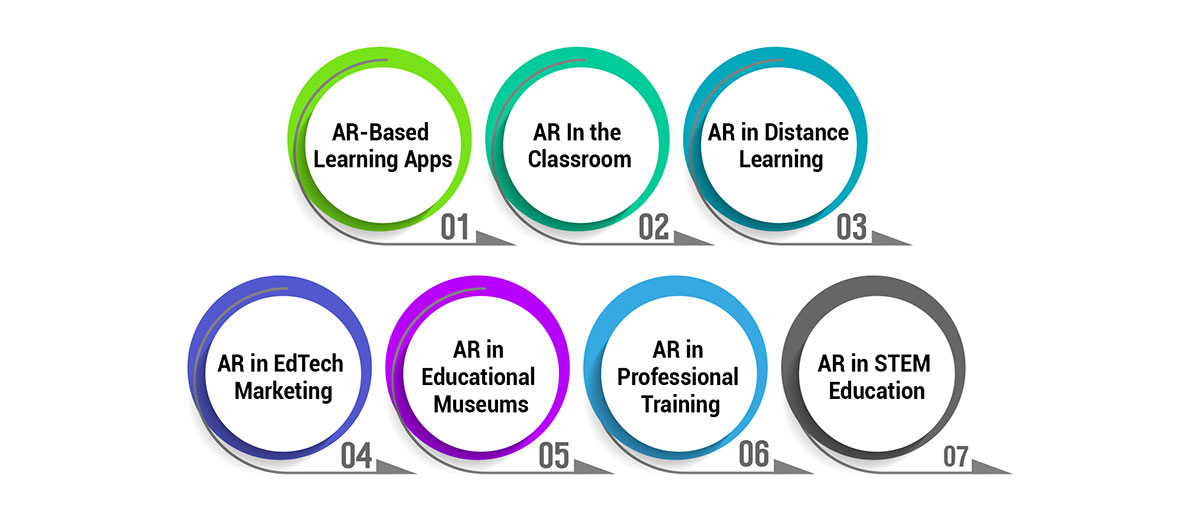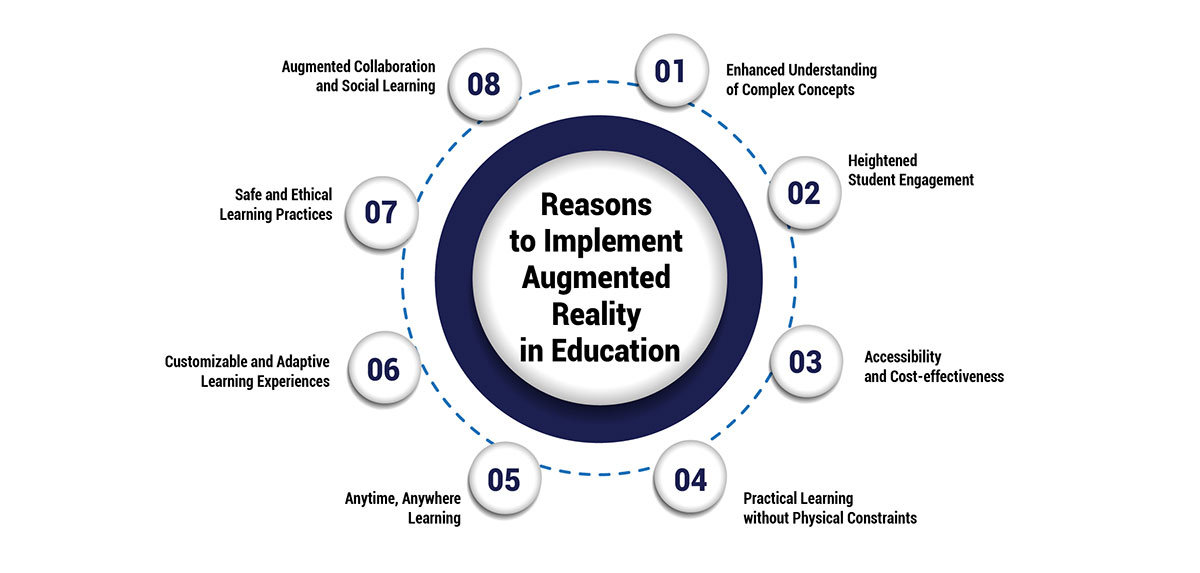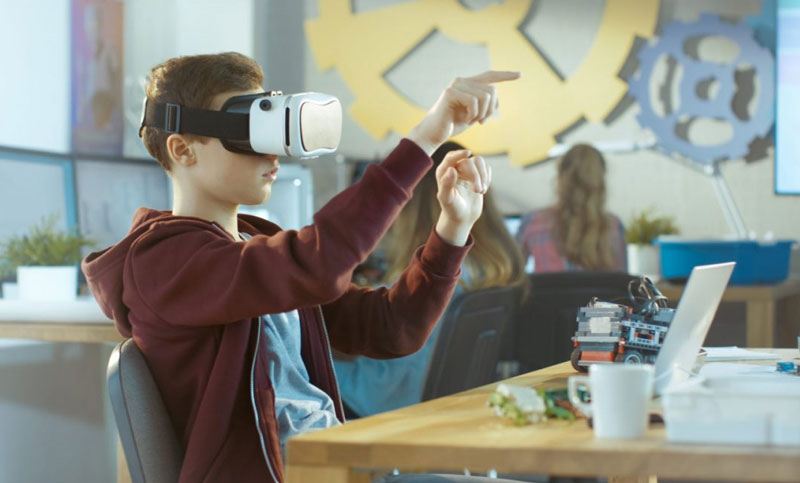The Role of Augmented Reality (AR) in Education
April 25, 2024As digital education evolves, augmented and virtual reality (AR/VR) are revolutionizing the eLearning landscape.
Formerly criticized for being dull, online education now captivates students with immersive experiences. It is noted that the educational sector is a major adopter of augmented reality.
Leveraging augmented reality/virtual reality addresses challenges of student engagement and facilitates better comprehension especially through 3D visualization.
Despite concerns about technology's impact on youth, AR's ability to enhance learning experiences is undeniable.
Exploring Augmented Reality in Education
In the realm of education, traditional teaching methods are gradually losing their appeal, with students increasingly disengaged due to standardized modes of instruction.
Augmented reality (AR) emerges as a transformative tool in this landscape, leveraging technology to enhance the learning experience.
Augmented reality (AR) in education refers to the integration of digital content, such as images, videos, and 3D models, into the real-world learning environment using technology.
Here, AR applications are used to visualize abstract concepts, provide interactive learning experiences, and facilitate immersive simulations tapping into the notion that visuals aid better memory recall.
Augmented reality in education goes beyond mere entertainment; it bridges the gap between abstract concepts and tangible understanding.
By visually transforming information, AR applications make complex ideas accessible and relatable, facilitating deeper learning experiences.
Research corroborates the efficacy of AR in education, with studies showing significant improvements in learning motivation, attention, satisfaction, and confidence among students.
Looking ahead, the future of augmented reality in education appears promising.
Studies demonstrate its superior impact on knowledge retention compared to traditional teaching methods, underscoring its potential to revolutionize the educational landscape.
As educators embrace AR technology, they open doors to immersive learning experiences that transcend the limitations of traditional instruction methods, empowering students to explore, engage, and excel in their educational pursuits.
Applications of Augmented Reality in Education
Let's explore the diverse applications of AR in education and how they benefit students and educators alike.

-
1. AR-Based Learning Apps:
Educational institutions and eLearning companies leverage AR to develop interactive learning apps, catering to learners of all ages.These apps combine education with entertainment, making learning enjoyable and engaging.
From language skills to mathematical concepts, AR-based learning apps cover a wide range of subjects, fostering retention and understanding.
-
2. AR In the Classroom:
In traditional classrooms, for instance, humanities subjects come to life as historical events and geographical landscapes are recreated within the classroom.
For STEM subjects, virtual experiments provide hands-on learning experiences without the need for physical equipment, enhancing comprehension and engagement.
-
3. AR in Distance Learning:
Distance education becomes engaging through AR-powered virtual classrooms and laboratories. Learners interact with instructors and peers in virtual environments, fostering collaboration and meaningful discussions.AR facilitates practical learning experiences, essential for technical courses, by simulating real-world scenarios and experiments.
-
4. AR in EdTech Marketing:
Educational technology (EdTech) companies leverage AR to showcase their services attractively. Virtual classrooms and facilities can be presented on websites, allowing prospective students to explore institutions remotely which aids in decision-making. -
5. AR in Educational Museums:
AR transforms traditional museums by creating virtual exhibits and immersive experiences.Learners explore scientific phenomena, biological processes, and historical events through interactive AR simulations.
Virtual environments provide comprehensive insights into complex subjects, reaching a wider audience beyond physical museum visitors.
-
6. AR in Professional Training:
In professional training, AR replaces traditional methods with virtual simulations and interactive modules.Trainees gain practical experience without the associated risks, enhancing safety and efficiency.
From medical procedures to aviation simulations, AR facilitates hands-on learning in diverse fields.
-
7. AR in STEM Education:
AR revolutionizes STEM education by making practical learning accessible and cost-effective.Virtual labs enable remote experimentation, allowing students to conduct experiments from anywhere.
Complex concepts are simplified through augmented presentations, bringing deeper understanding.
In spite of these, challenges such as hardware requirements and teachers' tech proficiency exists and can be addressed with proper support and training.
Reasons to Implement Augmented Reality in Education
Here's a comprehensive overview of the advantages of integrating AR into educational practices:

-
1. Enhanced Understanding of Complex Concepts:
AR enables students to visualize abstract concepts in a three-dimensional format, making it easier for them to grasp complex ideas. This immersive experience fosters deeper comprehension and retention of knowledge. -
2. Heightened Student Engagement:
By gamifying the learning process, AR captivates students' attention and creates an interactive learning environment. Engaged learners are more motivated to explore and participate actively in their education. -
3. Accessibility and Cost-effectiveness:
With the widespread availability of smartphones and tablets, AR eliminates the need for expensive specialized equipment, making learning more accessible to students from diverse socio-economic backgrounds.This democratization of education ensures that all learners have equal opportunities for interactive learning experiences.
-
4. Practical Learning without Physical Constraints:
AR simulations enable students to conduct virtual experiments and explore real-world scenarios without the need for physical laboratory equipment.This hands-on approach to learning fosters practical skills development in fields such as medicine, engineering, and sciences, where access to physical resources may be limited.
-
5. Anytime, Anywhere Learning:
AR applications empower students to engage in learning activities anytime and anywhere, transcending the limitations of traditional classroom settings.Whether at home, on the go, or in remote locations, learners can access educational content seamlessly through their mobile devices, promoting self-directed and personalized learning experiences.
-
6. Customizable and Adaptive Learning Experiences:
AR technology allows educators to tailor learning materials to meet the individual needs and preferences of students. By providing personalization, AR promotes adaptive learning strategies that cater to diverse learning styles and abilities. -
7. Safe and Ethical Learning Practices:
In disciplines such as anatomy and biology, AR eliminates the need for harmful or ethically questionable practices, such as animal dissection.Students can engage in realistic simulations and practical exercises without posing any risk to themselves or the environment.
-
8. Augmented Collaboration and Social Learning:
AR facilitates collaborative learning experiences by enabling students to interact with virtual models and share their insights with peers in real-time. This fosters collaboration, communication, and teamwork skills essential for success in the digital age.
Transformation Brought by Augmented Reality in Education
The integration of Augmented Reality (AR) in education has revolutionized traditional teaching methods and significantly impacted student engagement and learning outcomes.
In today's digital age, where students are increasingly distracted by smartphones and tablets, AR presents a unique opportunity to leverage technology for educational purposes.
Research from institutions like Harvard GSE indicates a decline in student engagement due to standardized modes of teaching. However, AR offers a solution by providing immersive and interactive learning experiences that captivate students' attention and foster deeper understanding.
Moreover, AR addresses concerns about technology's negative impact on students by utilizing smartphones and tablets as educational tools rather than distractions.
Instead of passively consuming information, students actively participate in their learning journey, making education more engaging and meaningful.
It is crystal clear that, the impact of AR in education is profound, offering educators innovative ways to engage students, enhance learning outcomes, and prepare them for success in a rapidly evolving digital world.
By embracing AR technology, educators can create dynamic and immersive learning experiences that inspire curiosity, creativity, and critical thinking among students.
Conclusion
The integration of Augmented Reality (AR) in education marks a transformative shift in traditional teaching methods, offering immersive and interactive learning experiences that captivate students' attention and enhance comprehension.
As digital education evolves, AR emerges as a powerful tool to address challenges of student engagement and facilitate deeper understanding of complex concepts.
By utilizing AR technology, educators can bridge the gap between abstract ideas and tangible understanding, promoting enthusiasm, creativity, and analytical reasoning among students.
Despite concerns about technology's impact on youth, AR's ability to enhance learning experiences is undeniable, offering a promising future for education in the digital age.
As we embrace AR technology in education, we open doors to a world of endless possibilities, empowering students to explore, engage, and excel in their educational pursuits.
With AR, the classroom becomes a dynamic and immersive environment where learning transcends the boundaries of traditional instruction methods, preparing students for success in an ever-evolving digital landscape.




